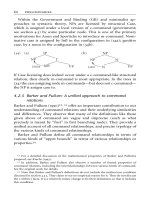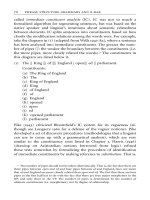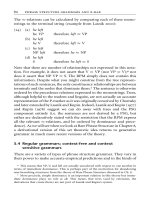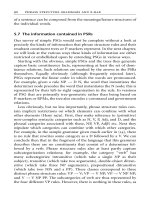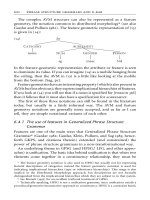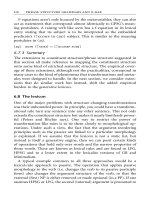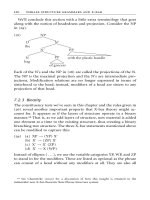Constituent Structure - Part 6
Bạn đang xem bản rút gọn của tài liệu. Xem và tải ngay bản đầy đủ của tài liệu tại đây (123.08 KB, 10 trang )
(b) Terminal node: A node that dominates nothing except itself.
(c) Non-terminal node: A node that dominates something other
than itself.
3.3.2 Axiomization of dominance
In an early article on the mathematics of constituent trees, Zwicky and
Isard (1963) sketch a series of deWnitions and axioms that specify the
properties of structural relations. These axioms were updated in Wall
(1972) and Partee, ter Meulen, and Wall (1990) (and discussed at length
in Huck 1985, Higginbotham 1982/1985, and McCawley 1982); more
recent axiomizations can be found in Blevins (1990),5 Blackburn,
Gardent, and Meyer-Viol (1993), Rogers (1994, 1998), Backofen,
Rogers, and Vijay-Shanker (1995),6 Kolb (1999), and Palm (1999).7
The axioms, while not universally adopted, provide a precise charac-
terization of the essential properties of the dominance relation.
Trees are taken to be mathematical objects with (at least) the fol-
lowing parts (based on Huck 1985):
(6) (a) a set N of nodes;
(b) a set L of labels;
(c) the binary dominance relation D (/*)8 on N (x/*y represents
the pair hx, yi, where x dominates y);
(d) the labeling function Q from N into L.
5 Blevin’s axioms actually exclude some of the principles discussed below, especially
those that disallow multidomination and tangling (line crossing). We will discuss Blevin’s
proposals in Chapter 10.
6 Backofen, Rogers, and Vijay-Shanker (1995) actually argue that Wrst-order axiomiza-
tion is impossible for Wnite (but unbounded) trees; they propose a second-order account
that captures the relevant properties more accurately. The proposal there is too complex to
repeat here; and since for the most part, Wrst-order description will suYce to express the
intuitive and basic properties of trees, we leave it at this level.
7 In this book, I have kept the logical notation to familiar Wrst-order logic. These latter
citations make use of a more expressive logic, namely, weak monadic second-order logic
(MSO), which allows quantiWcation not only over variables that range over individuals,
but also over variables that range over Wnite sets. The importance of this is made clear in
Rogers (1998) and discussed at a very accessible level by Pullum and Scholz (2005). MSO
characterizations are important for describing such things as feature-passing principles, all
beyond the scope of this chapter, which is why I’ve limited the descriptions here to Wrst-
order predicate logic.
8 For McCawley (1982) the symbol is æ and the relation is direct (i.e. immediate)
dominance. Others use the symbol # (unfortunately this symbol is also sometimes used
for ‘‘precede’’). I use Backofen, Rogers, and Vijay-Shanker’s (1995) unambiguous notation
(/*).
30 preliminaries
At the moment we will have nothing to say about the labeling function
Q, but will return to it Chapter 8 when we discuss the Bare Theory of
Phrase Structure. Our interest here lies in the relationship between
nodes (N) and their labels (L) as they are connected by the dominance
relation (D or /*). The axioms we propose over this relation can be
taken to be a formal deWnition of dominance.
The Wrst axiom that constrains the dominance relation is:
A1. DisreXexive:9 (8x 2 N) [x /* x].
This means that all nodes dominate themselves. This axiom is import-
ant for two reasons, both indirect. First, it will allow us to write a
deWnition that excludes a multiply rooted tree such as that in (7):
*
A
D
BCEF
In mathematics such trees are allowed; in syntax, by contrast, we want
our trees to be connected (however, compare the discussion of Bare
Phrase structure in Ch. 8, and the discussion of multidimensional
tree structures in Ch. 10). We must also exclude trees like that in (8)
(where arrows indicate a downwards dominance relation, even when
the relation is not downwards on the page), where, even though the tree
is connected, there is not a single root:
*
A
B
C (McCawle
y 1989)
In order to disallow structures such as (7) and (8), we need the axiom
in (A2):10
A2. The Single-Root Condition:(9x 8y 2 N) [x /* y].
9 This deWnition is based on that of Higginbotham (1982/1985), although the idea dates
back to at least Wall (1972), who changed Zwicky and Isard’s asymmetric dominance to
dominance, which is both reXexive and antisymmetric.
10 This deWnition is based on that in Partee, ter Meulen, and Wall (1990). McCawley
(1982) distinguishes two distinct conditions, one that requires that the structure be rooted,
and the other requires that the structure be connected. These are collapsed into this single
condition. See Collins (1997), who argues that this condition follows from Kayne’s (1994)
Linear Correspondence Axiom.
basic properties of trees 31
This axiom requires that there be some single node that dominates
every node in N. Since the variable notation here allows y ¼ x, it must
be the case that x can dominate itself for this to be true. So domination
must be reXexive for this to work. Graph-theoretically, (A2) has also
the eVect that syntactic trees are never cyclic.11 Cyclic graphs are ones
where the edges form a loop, as in (8). Take a graph with some number
of distinct vertices (v, an integer, where v $ 3). If the edge set contains
the pairs h1, 2i and hv, 1i, the graph is cyclic. Syntactic trees are never
cyclic because the single-root condition precludes any (other) node
from dominating the root, which is the initial symbol in the ordering
relationships expressed in the edge set. This means that all syntactic
trees are directed acyclic graphs (DAGs).
Second, (A1) allows us to restrict the form of terminals in a tree. In
many early forms of generative grammar (as mentioned above), all
terminal nodes consisted of a word hanging from a category node, as in
(9a). In the earliest versions of Chomsky’s phrase structural approach
(i.e. (1957), see Ch. 5 for more discussion), lexical items were inserted
by rules. They substituted for and replaced their category label. As
such, a notation like that in (9a) was appropriate.12 Gruber (1967)
was the Wrst to note the inaccuracy of (9a) for these approaches; the
matter has been discussed at length in Richardson (1982), Speas (1990),
Freidin (1992: 29), and Chametzky (1995, 1996, 2000). Nevertheless
many scholars continue to use, inaccurately13 in my opinion, the
notation in (9a) even when they assume principles that would actually
generate (9b).
11 The term ‘‘cyclic’’ is commonly used in the Principles-and-Parameters framework
and its ancestor, the Revised Extended Standard Theory, to refer to transformational
operations. It’s worth noting that cyclicity in transformations and the cyclicity of graphs
are unrelated.
12 This notation is also crucial for the Antisymmetry approach of Kayne (1994). In more
recent conceptions of generative grammar, the category of the terminal is part of the
terminal itself, (14b). Under this view, lexical items are not inserted as the last step in
phrase structure, they either are the terminal nodes (as in strictly lexicalist theories) or they
are inserted by a special transformational process (in late-insertionist models).
13 In the GPSG and HPSG frameworks, structures like (14a) are often licensed by a
special lexical rules, thus exempting them from this criticism. See, for example, the version
of GPSG discussed in Bennett (1995), or the HPSG in Sag, Wasow, and Bender (2000).
Another exception is the set of grammars described in Kornai and Pullum (1990), where
terminals (the words) are distinguished from preterminals (the categories) and all the
relevant relations are deWned making reference to preterminals only.
32 preliminaries
() (a)
*NP
(b)
NP
DN D
the
N
man
the man
The opposite of domination is a sort of ‘‘part of’’ relation. So in (9a, b)
the N is a part of NP. The reverse is not true, NP is not a part of N. So in
(9a), we assert that man is a part of N, but that N is not a part of man.
Every node is, of course, a part of itself (hence the intuition that
domination is reXexive). N dominates N, so N is part of N. The part-
of quality of domination tells us that when two nodes are part of each
other, they dominate each other, and that is only possible when they are
the same node. Consider now (9a). Under many current views (in a
variety of theories including Minimalism, HPSG, Categorial Grammar,
and LFG), the category of a word is the set of features that describe that
word (i.e. they form a Saussurian sign for the conceptual and syntactic
properties of the word itself). This information comes from the lexical
entry for the word, and cannot be deWned independently of the word.14
Ontologically speaking, then, the category is actually part of the word.
The category must dominate the word and the word must dominate the
category. Structure (9a) lacks this crucial property, thus it is incoherent
and ill-formed. If x ¼ y, and x dominates y,buty does not dominate x,
then axiom (A1)isviolated.For(9a) to be well-formed, where N and
man are the same thing, dominance would have to be irreXexive. So A1
rules out (9a) under this set of commonly held assumptions about the
way in which words get into the tree.
As we will see below when we look at c-command (Ch. 4), there are
circumstances where we may wish to relax the reXexivity axiom (A1).
Dominance that is not reXexive is called ‘‘proper dominance’’ (or
irreXexive dominance) and can be indicated with the symbol 3
þ
.
Proper dominance has all the other properties of dominance, except
those governed by axiom (A1).
The third axiom, (A3), states that the dominance relation is transitive:
A3. D is transitive:(8xyz 2 N)[((x /*y)&(y/* z)) ! (x /* z)].
This should be obvious. In fact, it is impossible to draw a tree in two
dimensions, where some x dominates y, and y dominates z, but x does
14 Unlike in the old phrase structure system that underlay structures like (9a), where the
N category came from the rule, not from the lexical entry of the word.
basic properties of trees 33
not also dominate z. Whether this is an empirically correct result or
not is a matter of some debate. In Chapter 10, we look at theories of
constituent structure which branch into three dimensions, where (A3)
may or may not hold.
The relation of dominance is also antisymmetric;15 this is formalized
in axiom (A4).
A4. D is antisymmetric:(8xy 2 N)[((x /*y)&(y/* x)) ! (x ¼ y)].
This means that the relation is unidirectional: x cannot both dominate
y and be dominated by y, unless x and y are the same node. This allows
us to rule out trees such as (10) (where again the arrow indicates
‘‘downwards’’, even though it is not downwards on the page.)
() * A
B
Were the edge sets of trees not directed (using ordered pairs), such
structures would be ruled out on general principles of set theory (the
sets {A, B} and {B, A} being equivalent). However, since we are dealing
with ordered pairs (hA, Bi 6¼hB, Ai), we need (A4) to rule such
structures out and guarantee acyclicity in the graph.
Finally, consider the tree in (11):
*A
BC D
bc d
It is usually assumed (although not universally, see the discussion on
multidomination in Ch. 10) that elements such as c cannot be domin-
ated by more than one node that are not themselves related by dom-
inance—In other words, a node can not have more than one mother.
This is ruled out by (A5):16
A5. No multiple mothers:(8xyz 2 N) [((x /*z)&(y/* z)) !
((x /*y)_ (y /* x))].
15 Zwicky and Isard’s original axiom held that the relation was asymmetric ((9xy 2 N)
[(x /*y)!:(y /* x)]) but this, of course, contradicts (A1)—which was not part of
Zwicky and Isard’s original set of axioms (see n. 9).
16 Based on Higginbotham (1982/1985). See Sampson (1975) and Blevins (1990), who
argue that the single-mother requirement should be relaxed and multidomination allowed.
34 preliminaries



